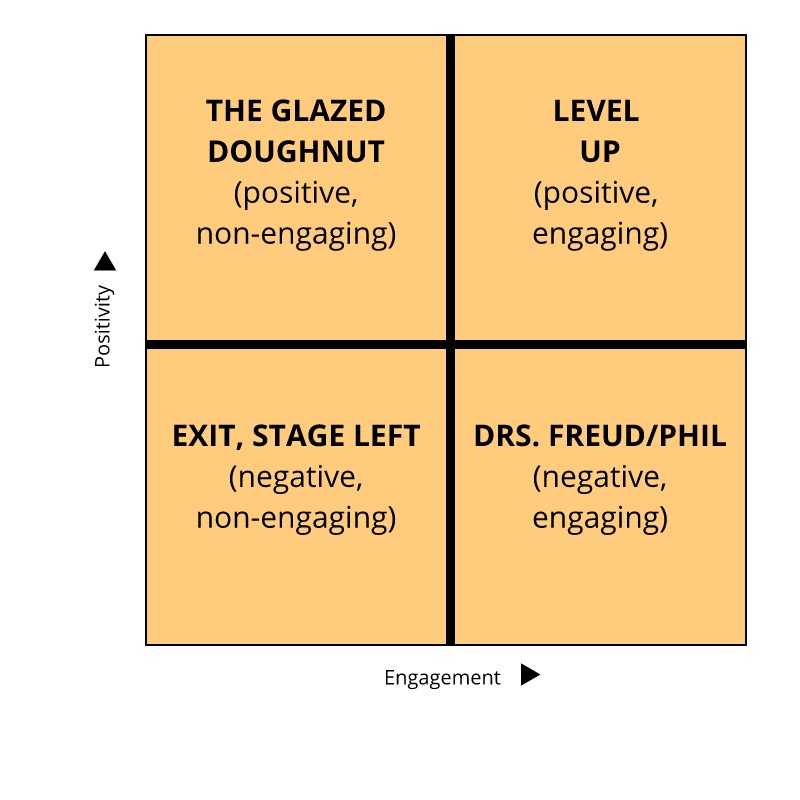4 Ways to Deal With Negative People

My client Kristen was frustrated. She was running into a common problem that I hear about every day, and it’s probably something you’ve dealt with, too
“Craig,” she said, “I try my best to hang around positive people and spend time with coaches and mentors, but there always seems to be a get-together with negative people who just want to argue about sports and politics. Worse, I have an in-law who just talks my ear off with gossip. What do I do?”
Outside of joining a monastery, there’s not much you can do to COMPLETELY avoid negativity. Every ETR reader is going to get in the odd conversation that brings us down.
But there are ways to deal with people stuck in the complaint zone. In fact, it’s imperative that you learn how to deal with them so that they don’t derail your pursuit of big goals and dreams. That’s why we have to cover it today. Fair warning, though: My advice will come in traditional Craig style—politically incorrect and uncomfortably straightforward. (You know it’s going to be a good article when I ran it past two of my colleagues and one of them loved it and the other said, “What utter bollocks!”).
I’ve thought about the predicament of “dealing with negative people” for hundreds of hours over the years because it’s an issue I’ve faced time and time again. It was an especially common problem when I was a young man trying to give up drinking and idle talk at the bar.
Eventually, I created a four-approach system for dealing with negative people.
To understand it, picture a four-quadrant diagram set on two axes. The vertical axis shows an increase in positivity, so the top quadrants offer more positive approaches to negativity. The horizontal axis shows an increase in engagement, with more “engagement-heavy” approaches to the right of the diagram.
 Now, let’s break down each of the quadrants and what they mean.
Now, let’s break down each of the quadrants and what they mean.
Bottom-Left Quadrant (negative, non-engaging)—Exit, Stage Left
There’s a great example of this in the movie “Rush Hour” with Chris Tucker and Jackie Chan.
After a tense scene, Tucker’s character asks Chan’s, “How do you stay so cool all the time?”
“Because I don’t get into arguments with stupid people,” Chan’s character replies. “I just cut it short and say, ‘You are right’.”
“But that’s completely irrational and wrong.”
“You are right.”
Funny, huh? But it’s also simple.
So is the Exit, Stage Left approach: Just get up and leave.
Unfortunately, this is rude. No one wins.
However, sometimes it’s worth using.
For example, when I was a young man, I paid my way through college by working a factory job in the summers. On Friday nights, I’d often find myself in a bar engaged in hopeless conversation with a well-meaning, but jaded factory “lifer.” They complained about their lot in life. I couldn’t fix those issues. And besides, there was a pretty girl on the dance floor. So, I’d just get up and walk away.
The chances of you being in this situation are slim. However, if you’re engaged in conversation with someone who is incredibly nasty and negative, sometimes you have to resort to this method.
If the negativity is overpowering, exit stage left.
Top-Left Quadrant (positive, non-engaging)—The Glazed Doughnut
If you’ve ever watched “The Simpsons,” you’re familiar with Homer Simpson’s tendency to let advice go in one ear and straight out the other.
Picture yourself as a real-life, vacuous Homer.
The next time you’re forced to sit through a blathering idiot’s rant, a holier-than-thou pontification about football, or a diatribe on the virtues of Boba Fet in “Star Wars,” just zone out. Sit there and daydream. Allow your eyes to glaze over and stare into space as your mind wanders and thinks of something else.
It takes practice, but you can become very good at mentally organizing your day, making a grocery list, or coming up with content ideas for your email newsletter—all while people think you’re listening.
This can backfire, of course. If people notice your Glazed Doughnut eyeballs and call you out on your Homer routine, it can be very embarrassing. In fact, I wouldn’t recommend trying this with your partner at home! But in the right circumstances, and with the right amount of practice, you can turn futile and adolescent conversations into productive time.
Bottom-Right Quadrant (negative, engaging)—Drs. Freud and Phil
This method takes a lot of energy and can leave you exhausted. Imagine being Michael Clark Duncan’s character in “The Green Mile,” inhaling everyone else’s pain and taking their suffering on your back.
Here’s how it goes:
When someone comes to you to complain, instead of changing the subject or using the Glazed Doughnut approach, listen—and encourage a rant.
Lean in. Ask uncomfortable questions. Dig deep. Get to the bottom of it. Be a shoulder for them to cry on (if it gets to that point). Soak up all the negativity.
If they are complaining, they clearly have a problem. And if they have a problem, they want a solution. And if they’re sharing their problem with you, it’s because they think you can help them find one. Maybe you can.
Do your best Dr. Sigmund Freud (or Dr. Phil) impression and ask questions to encourage sharing. Immerse yourself in their pain.
It’s possible this will lead to a breakthrough. If so, you will know how to leverage the Dr. Freud approach again.
Unfortunately, however, the odds of success are slim. If you fail to find a solution, you will know at least that this is one scenario were Dr. Freud is useless.
Top-Right Quadrant (positive, engaging)—Level Up
One of the best lessons I’ve learned after being interviewed on over 185 podcasts is this:
“The quality of a conversation is directly proportional to the quality of the questions.”
If you are a good communicator, you can lead the conversation. You can ask the right questions that turn the discussion in a positive direction. Contrarily, if you ask the wrong questions, things can turn negative quickly.
With the Level Up approach, lean in and push your complainer in a positive direction. That positivity will change the discourse and ultimately lead your “negative Nancy” to find a solution themselves.
This is your chance to make the best of a bad situation, so…
- When someone complains, ask how they can fix the problem. Focus on the solution.
- When someone speaks badly of another person, ask them what they like about that person.
- When someone is cranky, be cheerful.
- When someone has low energy, elevate yours.
- When someone questions—or even mocks—your behavior, be proud and open; explain yourself to them.
None of these is easy. That’s why this option is called Level Up.
But the quality of your conversations and interactions in life requires you to become the best version of you. Difficult times and environments push you beyond your comfort zone. That’s where the growth happens—both for you and those you interactive with.
Eventually, you will get better at handling negativity. Listening and learning helps you build a better understanding of others and shows you how the other half thinks.
You will also likely become more compassionate, tolerant, and wise.
So turn up the quality of your conversations, no matter how negative they begin.
And the next time someone dismisses your ideas as “utter bollocks,” well, you can lean in and school them with proud positivity.

Want a daily dose of positivity from ETR Editor Craig Ballantyne? Follow him on Instagram for life lessons, business insights, and a lot of personality. This is one dose of social media you’ll look forward to every day!
